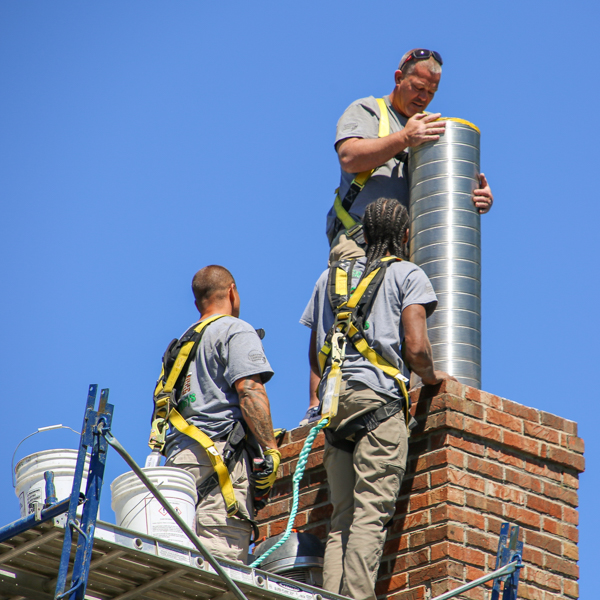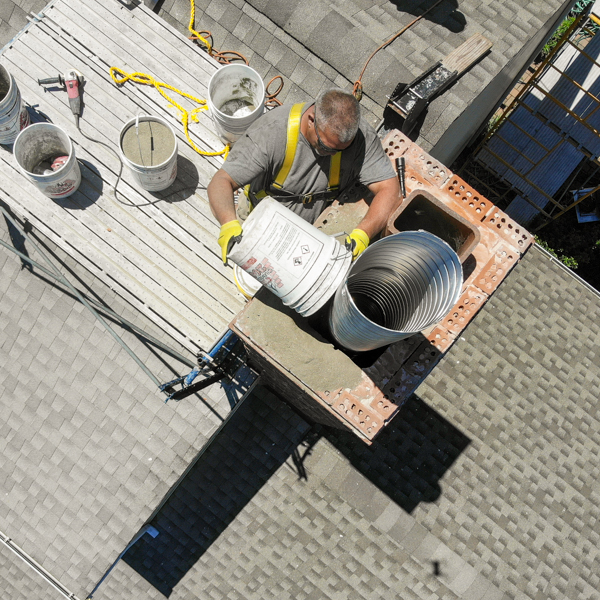Does My Chimney Need a Liner?
Whether you’re new to owning a chimney or a seasoned veteran, there’s always something new to learn to keep your fireplace running safely and efficiently. At Mercer County Chimney Service, you can call us for all of your fireplace and chimney needs. In this article, we look at your chimney liner and answer whether you need one or not.
 What Does a Chimney Liner Do?
What Does a Chimney Liner Do?
According to the Chimney Safety Institute of America, a chimney liner is a clay, ceramic, or metal conduit installed in the chimney to contain the combustion products and direct them to the outside. The chimney liner also protects the masonry and chimney walls from heat and corrosion.
Does My Chimney Need A Liner?
In a word, yes, and here’s why.
A Chimney Liner Prevents Overheating
One of the primary functions of your chimney liner is to protect the chimney from overheating and fire. One of the most common causes of chimney fires is a poorly maintained flue, and the chimney liner is the first line of defense to guard against accidental fire.
If the temperature in the flue gets too high, it can ignite support structures and other combustible framing materials. The chimney liner directs the heat away from these structures to prevent fire.
Chimney Liners Prevent Damage to the Masonry
Another critical role the chimney liner plays is protecting the masonry. While most of us think that brick is a robust building material, the fact is it’s porous, as is the mortar holding the brickwork together.
When you have a fire in your wood-burning stove or fireplace, it releases various byproducts that are corrosive to the brick and mortar. Over time, these corrosive elements eat away at mortar joints, causing structural damage.
Chimney Liners Provide You With The Correct Sized Flue
If you install a modern wood-burning stove or fireplace, it typically requires a certain sized flue for safe and efficient operation. However, if you have an older home, your chimney’s flue may be the wrong size. Installing a chimney liner ensures your flue matches your fireplace or stove, so you get the best results.
How To Know If My Chimney Liner Needs Replacing
So, having a chimney liner is critical to your safety and the efficiency of your wood-burning stove or fireplace. But all of that goes out the window if your chimney liner falls into disrepair.
For safety’s sake, it’s recommended you call a professional chimney service for an annual fireplace and flue inspection, but here are the most common signs that it may be time to replace the chimney liner.
Infrequent Chimney Inspections
Experts recommend annual chimney inspections, so if you can’t remember the last time you had a certified technician look at your fireplace and chimney, then it’s been too long. Infrequent safety inspections allow minor problems to escalate into situations that could become deadly under the right conditions.
Your Chimney Has Venting Problems
Clay chimney liners are the most common; they’re inexpensive to install, and the materials are widely available. However, clay wears out more quickly than other materials, leading to venting issues.
If you notice chimney downdraft or smoke coming back into the house, called back puffing, maybe the chimney liner is worn out and needs replacing.
You’ve Had a Chimney Fire
It might sound hard to believe, but some people experience chimney fires and don’t know it.
When we envision chimney fires, we see flames and smoke billowing from the roof of the house, but the fact is that most chimney fires are slow-burning, and the only evidence is melted mortar or roof damage.
Some people attribute smoke spilling into the house as back puffing instead of a chimney fire. Other times, people hear crackling or popping sounds coming from the flue and think it’s normal.
If you’ve ever had a chimney fire, you must replace the liner, full stop.
How Long Does A Chimney Liner Last?
The average lifespan of a flue liner is between 15 and 20 years; however, many factors can increase or decrease that time, including the liner’s material.
Clay liners are more vulnerable to wear and tear and have the shortest lifespans, and many don’t even make it five years. Stainless steel comes in second as it’s more durable than clay and is better at mitigating heat. Last, cast-in-place chimney liners are lightweight, cement-like products that can last up to 20 years or more with proper maintenance; however, these are the most expensive to install.
The best way to ensure your chimney liner lasts as long as possible. It is efficient at doing its job is by hiring a certified chimney specialist for yearly inspection and maintenance.
 About Mercer County Chimney Service
About Mercer County Chimney Service
Mercer County Chimney Service is a full-service chimney company providing a comprehensive list of stove, fireplace, and chimney services, including:
- Chimney sweeping
- Chimney inspections
- Furnace flue cleaning
- Chimney waterproofing
- Chimney repair & maintenance
- Liner installation
- Brick and masonry repair
- Chimney flashing
- And more!
We’re a certified member of the Chimney Safety Institute of America and the National Chimney Sweep Guild. Our staff is fully licensed and insured. We’re located in Hamilton, NJ, and we serve homeowners throughout Mercer County, NJ, including Plainsboro, Ewing, Hopewell, and Pennington.
Contact us today with questions or to schedule your appointment by phone at 609-802-5288 or online.


